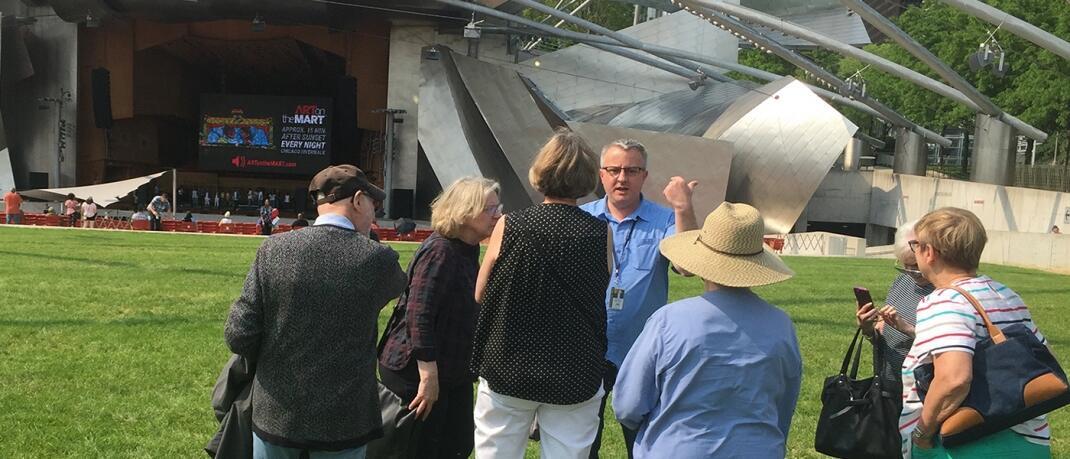News
In Spite of Closure, Readying Chicago’s Famous Playground for the Arts
| By Noel Morris

When we are able to open our doors, our biggest service will be to give people a place where they can come and get away from all their worries.
When Scott Stewart heard the City of Chicago would be closing Cloud Gate (“the Bean”), he wondered how Anish Kapoor, the artist who designed the famous landmark, would react. As executive director of the Millennium Park Foundation, it was Stewart’s job to reach out to the London-based artist—and to maintain relationships with each of the original members of the Park’s creative brain trust.
“I communicated with all of them about the Park’s closing: the landscape architects, Piet Oudolf [Lurie Garden], Jaume Plensa [Crown Fountain], and Kapoor [Cloud Gate],” said Stewart. “Without exception, they told me: ‘you’re doing the right thing.’”
I’ve been calling all my colleagues around the country—Central Park, Bryant Park, Golden Gate Park—to brainstorm ways of enforcing physical distancing.”
Under normal circumstances, the Millennium Park Foundation vigorously defends its founding principle to keep the Park free and open to the public. But these are not ordinary times. As the coronavirus spread throughout the state, a cascade of events took place signaling the shuttering of the city: first there was a run on grocery stores, then came the closing of restaurants and cultural institutions, and finally Mayor Lori Lightfoot shut down Chicago’s lakefront and Millennium Park.
Today, Zoom meetings and face masks help break the monotony for the millions sequestered at home, but Stewart remains acutely aware of this now invisible community: typically, Chicagoans spend much of their lives in public spaces. When Millennium Park reopens, he needs to be ready. At the same time, he’s having to make some practical choices in light of the shifting timeline, one governed by a microscopic pathogen. (Already, the Department of Cultural Affairs and Special Events has cancelled Blues Fest, Gospel Fest and the House Music Conference and Festival.)
Having the Park closed does present certain opportunities. “We’ve had tree pruners working for the last month, something we’ve needed to do for the past ten years,” said Stewart. “We’ve rebuilt the stairs at Washington and Madison, and at Columbus and Monroe. And something I’ve been interested in for a long time: looking at some of the areas in the park that were utilitarian, and making them into artful spaces. You know, here we have the Harris Theater and the Jay Pritzker Pavilion—they’re performance and music spaces. The surrounding landscape should reflect that.”
In terms of managing the public, Stewart unexpectedly finds himself in the position of having to work with the city to bring entirely new policies into existence—there’s no playbook for reopening a park in the wake of pandemic.
"I’ve been calling all my colleagues around the country—Central Park, Bryant Park, Golden Gate Park—to brainstorm ways of enforcing physical distancing.” And of course, City officials are looking to science to help inform these policies, as well as cleaning protocols.
Much has been written about the transformative impact of Millennium Park. Since its 2004 opening, the property, which once consisted of a parking lot and railroad tracks, has spurred billions of dollars in new construction. In 2016, the Park surpassed Navy Pier as the Midwest’s most popular tourist attraction. Through it all—the arrival of souvenir shops, tony high-rises, and gourmet markets—the mission of Millennium Park is unchanged: to maintain a free public space, and present programming that reflects the city’s diversity. Thus, as Chicago slumbers, the Millennium Park Foundation is making it ready, preparing for the all-clear when Chicagoans can reclaim their spot on the Great Lawn.
“When we are able to open our doors, our biggest service will be to give people a place where they can come and get away from all their worries,” said Stewart. “And when they come back, in a post-COVID world, I have a feeling they’ll notice details about the Park they had overlooked before.”